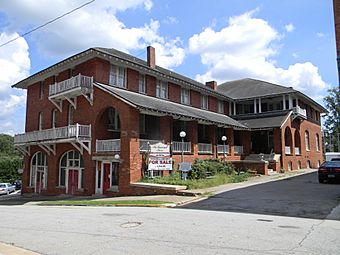Abbeville Historic District (Abbeville, South Carolina) facts for kids
|
Abbeville Historic District (South Carolina)
|
|

Belmont Inn, originally the Eureka Hotel (c. 1890), on the old town square
|
|
| Location | Roughly bounded by Seaboard Coastline RR, SR 72, Rickey, Haight, Hemphill and Haigler Sts., Abbeville, South Carolina |
|---|---|
| Built | 1786 |
| Architect | Multiple |
| Architectural style | Includes Second Empire, Gothic Revival, Beaux-Arts, Queen Anne, Bungalow, Greek Revival, Victorian |
| NRHP reference No. | 72001183 (original) May 7, 1984 (increase) 72001579 (decrease) |
Quick facts for kids Significant dates |
|
| Added to NRHP | September 14, 1972 |
| Boundary increase | May 7, 1984 |
| Boundary decrease | September 14, 1972 |
The Abbeville Historic District is a special area in Abbeville, South Carolina. It is recognized for its important history and old buildings. This district is listed on the National Register of Historic Places. This means it is a place that the United States government wants to protect.
The district includes many famous buildings. Two of these are the Abbeville County Courthouse and the Abbeville Opera House. These buildings are also listed as important on their own. The Abbeville Historic District was first added to the National Register on September 14, 1972.
The size of the district has changed over time. When it was first created, it covered a certain area. Later, in 1972, a small part of the district was removed. Then, in 1984, the district grew much larger. More historic buildings were added to its protected area.
Discover Abbeville's Past
The Abbeville Historic District covers a big part of Abbeville. This city is the main town of Abbeville County. Abbeville was founded in the late 1700s. It played a big role in the history of South Carolina.
One important event happened here before the Civil War. People in Abbeville held one of the first public meetings. They talked about leaving the United States. This meeting was a step towards the Civil War.
Buildings and Architecture
Most of the shops and businesses in the district are from the late 1800s and early 1900s. This is because of three big fires. These fires happened in 1872 and 1873. They destroyed many older buildings.
After the fires, new buildings were put up. This gave the town square its current look. You can see many different styles of buildings here. They show how architecture changed over time.
Important Historic Sites
When the district was first created, 16 sites were named as very important. These included homes, businesses, and even a park. They helped show the history of the area.
Here are some of the original important buildings:
- Abbeville Press and Banner Building
- Ace Hardware Building (built in 1831)
- Old Bank Building
- Abbeville Opera House
- Abbeville County Courthouse (built in 1903)
- The Burt House (around 1830)
- Secession Hill (a historic park)
- Trinity Episcopal Church (built in 1860)
- Quay-Adams House
- Wardlaw-Klugh House (built in 1831)
- Lee-Reid House (built in 1885)
- McGowan-Barksdale House (built in 1888)
- Gary-Harris-Wren House (built in 1885)
- Harris House (built in 1886)
- Gary-DuPree House (around 1885)
- Shillito-Townsend House (around 1830)
In 1984, the district grew much larger. Many more buildings were added to it. Today, the district has 37 very important buildings. It also has 282 supporting buildings. Plus, there are 209 other buildings within its borders. This makes a total of 528 sites. Most of these buildings are still standing today.



